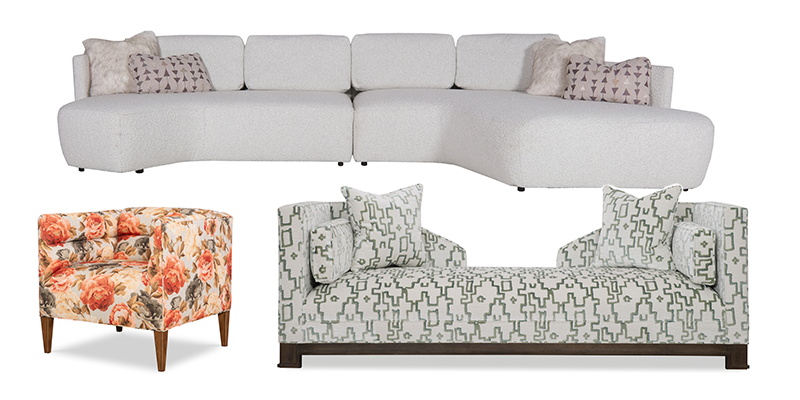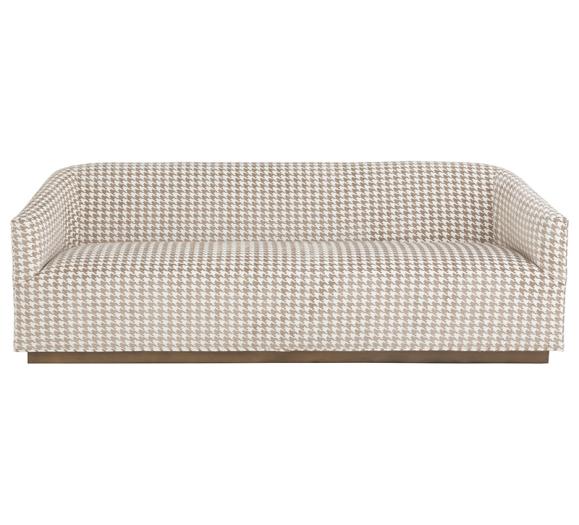As consumers continue to update their living spaces, much of the attention has been on upholstery, the home furnishings that are designed for comfort as well as aesthetic. While comfort has always been a key component in quality upholstered furniture, as the pandemic has had consumers spending far more time at home, comfort and flexibile seating options have become even more of a focus.
“We’ve been nesting,” says Dixon Bartlet, Chief Creative Officer at Norwalk Furniture. “We’re seeing a preference for softer pieces that you sit in rather than on; cozy curl-up pieces with organic shapes that are comfortable. Anything that is soft in its profile is getting a lot of attention.”
Organic shapes, while providing those good “curl-up” angles, are also part of a larger trend toward embracing the outdoors and elements we find in nature. In other home furnishings categories, we’ve seen an increasing use of natural materials, such as abaca and bamboo. In upholstery, organic shapes such as curves and warmer-toned, textured fabrics continue to gain traction in what had been a gray-dominated field.
“Nature implies curves, authenticity and relaxation,” says Zack Taylor, President of Wesley Hall. “Modern design isn’t around a living room and dining room anymore,” he adds, noting that more fluid living spaces have become more the norm. Because of a more open-floor-plan approach to living, newer furniture designs that feature unique angles and curves are designed to make furniture approachable wherever the eye lands. “Today’s furniture is as beautiful from any angle to the next,” Taylor notes. “It’s also being designed in a way to perch on the arms or back of a piece.” In addition to the curves that are prominent in today’s seating, there has been a notable increase in wide track arms designed for perching, for example.
While organic shapes are designed to deliver that natural feel, they are not without their logistical challenges. “There has to be integrity in the way these pieces are built,” Taylor says. “The furniture has to look good and function from all of these angles.”
Details that require attention include thicker padding on arms or lining up the fabrics. “There’s more time and labor to getting those upholstery shapes just right.” says Norwalk’s Bartlett. “Particularly with a patterned fabric, pattern matching becomes more complicated.”
Taylor adds, “Quality really starts at the foundational level, the hardwood frame.” Wesley Hall uses American-grown sustainably forested white maple for its frames. “That hard wood gives you the ability to have pitch and shape and finesse. Curving down to give a great pitch puts a lot more strain on the furniture. You can’t do that with plywood.”
On the Surface
Textured fabrics and warmer colorways are also trending. Colors continue to move away from cooler tones toward such hues as milk chocolate or paper bag brown, a color Bartlett says was identified as a color of the year by one marketing group.
Wesley Hall’s Taylor agrees that color palettes are warming, noting that warm brown grays have seen a notable rise. He adds that in addition to those warmer tones, performance fabric is a must on today’s upholstery. “Performance continues to drive the day-to-day textile world,” Taylor says, as consumers are actually living in their sofas and chairs, and want them to stay beautiful and easy to clean. “Upholstery has become multifunctional, multi-faceted pieces of furniture,” he continues.
Texture also continues to play an important role in the softening of upholstery. Boucles, for example, were inviting market-goers to take a seat in many High Point Market showrooms.
Younger Consumer Trends
As younger consumers — Millennials and Gen Z — are setting up homes, upholstery makers are seeing styles specific to these generations. While overarching trends lean toward casual comfort, Bartlett says he is also seeing a trend toward soft contemporary — cleaner and more defined shapes, whether organic or linear.
Taylor is also seeing more defined style among the younger consumer, although at Wesley Hall, that’s leaning toward traditional. “For some young designers and customers, traditional elements look brand-new to them.” He’s seeing a return to such design elements as Bullion fringe or ruffled skirts. Taylor continues, “If you watch the fashion styles, it’s not often long before those elements move to furnishings.” Both execs also note that more masculine, tailored pieces are seeing an uptick.
Whether fabric choice or sofa shape, upholstery pieces are a personal decision. Depending on region, generation and more, while some trends appear prominent, others are driving production in the background. Take the question of larger or smaller pieces, for example. According to Norwalk’s Bartlett, upholstery piece size depends on the individual customer, one reason the company introduced its modular sofa/sectional system this year. “Size is driven by the room in which the piece is going,” he notes. “In Texas, we can hardly make something big enough. In Boston, the smaller, the better. As a company that has national dealers, we try to have a smattering of all those things in each show.”
Trends aside, upholstery furniture is ultimately about comfort. “Sleek lines can be beautiful,” Taylor notes. “If it doesn’t sit right, it’s not worth it.”







